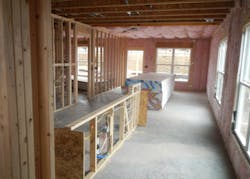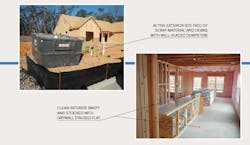A clean, well-organized jobsite is a visible asset with a clear return. It broadcasts competence, helps workers be more efficient, reduces liability, and makes prospective homeowners more apt to choose you as their builder.
A messy, disorganized site broadcasts that you don’t pay attention to detail and it leads people to scrutinize your work. Inspectors may find more code violations, current homeowners will discover more faults (before and after they move in), and prospective homeowners may decide to look elsewhere.
Construction Jobsite Organization Is a Matter of Mindset vs. Money
Jobsite debris also raises safety issues. Trips, falls, and workers’ comp claims arise from a variety of conditions—everything from scattered scraps of lumber to wet mud tracked into the house. Those who have no business being on the jobsite will inevitably walk onto your site on the weekend; it’s a common problem. Yet trespassers are more likely than workers to injure themselves. Case in point: the Illinois homeowner who sued her builder and drywall contractor for $300,000 plus medical costs after a stack of drywall fell and injured her leg. You don’t need that kind of trouble.
The organization of your jobsites—or the lack thereof—is also a sign of how consciously or carelessly your crews manage materials. In my experience, jobs with neatly stacked lumber see fewer variance purchase orders for extra stock than those with plywood and 2x4s scattered around in the dirt.
The good news is that avoiding these problems doesn’t cost much. It’s more mindset than money. The only real expense is a dumpster and a regular schedule with the hauling company. Chances are you already have those. You’re probably not the builder who throws debris into plywood pens that get filled to overflowing before being emptied.
Get Buy-In From Subcontractors for a Clean, Well-Ordered Jobsite
Getting subcontractors onboard requires being clear with them about your expectations. For instance, you should insist that the brickmason remove bricks from staging planks and pick up all offcuts at the close of each day.
You also need a jobsite supervisor who is committed to keeping the job clean. That includes making sure workers keep materials and debris out of the path of circulation, providing safe access to the home, and broom sweeping the house at the end of each workday. End-of-day cleanup is vital: even sawdust, small lumber offcuts, and wire scraps can leave a negative impression with homeowners and can undermine the expectations that you have set with your subcontractors.
How do you motivate subs to comply? The most effective builders I know have written policies and are willing to fine subs that don’t clean up after themselves. If the builder sees a violation of those policies, they take a photo and send it to the sub with a date stamp. In larger communities, some builders also hire a dedicated laborer to come in twice a week and clean up any items the work crews missed.
The best way to motivate yourself is to remember the payoffs: fewer injuries, more productive crews, and a very visible, very effective marketing tool.
A few simple things to consider:
• Put dumpsters where workers will use them
• Broom-clean the interior each day
• Keep the interior and exterior free of trip hazards
• Provide a clear, safe entry path to the site and the home
• Use gravel track pads and silt fencing to keep the street clean.
John F. Koenig drives quality and performance in home building as a specialist of the PERFORM Builder Solutions Team at IBACOS.


